Guide to the Circle City[]
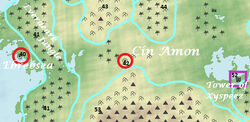
Any traveler on the caravan trail through this arid region will eventually find the famed city of Cin Amon. To local residents as well as clanspeople from nomadic tribes in the region it is also known as the "Circle City" due to its strictly circular layout. In the middle of the settlement lies the pompous, walled-off city core, which is surrounded by a second ring of four burrows which has its own wall and tower defense.
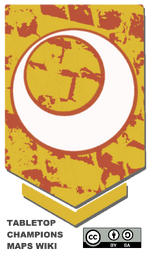
"With great power come bigger fish to fry."
Cin Amon reigns only over a few dependent settlements in this region, yet the city is excessively rich. Its wealth derives from a legendary gold vein under the hills it was originally built upon, but the gold source was exploited a long time ago. Ever since, Cin Amon has used its wealth to import all kinds of valuable materials over the caravan trai. The artisans and craftspeople in the city then work these into expensive artifacts of luxury and art and sometimes, for affluent customers, magical weaponry.
The neighbours of Cin Amon do not only envy it, they must also fear it. The rulers of the Circle City like to honor their tradition of raising mercenary armies of intimidating size, and declare war on independent domains in the region. These wars are often short, and will end with the assaulted side delivering hefty tributes in order to be left unharmed, or, in the worse case, with the troops from Cin Amon pillaging the victims out and dragging their riches back to the Circle City.
Things to do and places to see in the Circle City[]
The Inner City Circle (non-citizens are permitted with a formally documented invitation from a Citizen)
- (1) Royal Palace
- (2) Great Begzadii Assembly
- (3) Temple to Khnum (under construction)
- (4) Collegium Arcanum: this is a dependancy of [YOUR PLACE]. The current leader is [YOUR NPC].
- (5) Great Library (vaults of tomes and artifacts)
- (6) Theater: current leader is [YOUR ELVEN NPC]
- (7) The Elven House: a guesthouse run by an old Elven family, currently owned by [YOUR ELVEN NPC].
- (8) Archer barracks
- Important temples to: K'cul, [YOUR HORSE DEITY], [YOUR WATER DEITY].
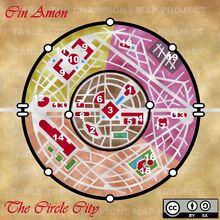
The market district (everyone is welcome)
- (9) Great Market Halls
- (10) Great Pantheon dedicated to all deities
- (11) The Shaking Hands (trader's guildhouse)
- (12) Arena: professional gladiators and gladiator school. The current champion is the druid [tbd] from Fiwanting.
- Famous tavern: Alton's Brown Cantina (try their grilled grilled goat cheese sandwhich!)
- (13) Guard barracks and jail
The residential district (outsiders are permitted, not welcome)
- (14) Hippodrome
- (15) Academy
- (16) Minor pantheon centered around Khan Bhaalic.
- Places to stay: The Circle City Gaze (guesthouse), The Abandoned Groom (tavern, B&B)
The manufacturing district (outsiders are permitted, not welcome)
- (17) Temple to [YOUR ELVEN DEITY OF INSPIRATION]
- (18) Temple to [YOUR DEITY OF THE CRAFTSPEOPLE]
- Blacksmith's Guildhouse
- Wyvern Tower
- Notorious taverns: The Ginger Dancer, The Tanner's Tomb.
The Cage (19 - no outsiders permitted)
Shopper's Guide[]
The following equipment should be easily obtainable in the Circle City. When shopping here, expect to pay more than you would elsewhere. Quality goods and shrewd negotiation is what this city thrives on.
- Armor (good quality, full price range): light, medium and shields; no heavy.
- Melee weapons (high quality, full price range): normal, light, finesse, reach; no heavy.
- Ranged weapons: all except crossbows. Bows are Elven quality and expensive.
- Mounts (full price range): all horses (top notch), mules, camels.
- Arcane and priest supplies: priests can get almost anything at a friendly temple; magic users must be able to inquire at the collegium arcanum (for research and basic supplies).
- Training: various proficiencies can be studied at temples, guild houses, the arena, hippodrome or academy. Bards and magic users must first obtain access to the theater or collegium arcanum.
It might be possible to get +1 stuff, but you must know someone, and you still might have to pay through your nose. Similar to goods, lifestyle and other expenses are also more pricey here.
Notable NPCs[]
Some say strange things are afoot in the Circle City, concerning Arul Af'Un and Megaera.
Local oddities and customs[]
When meeting, people commonly say "Well met!", as they would anywhere. The formal greeting however is a nomadic phrase in a forgotten dialect: Qaffwa en'te! Loosely translated, it means 'We better get some coffee into you!"
Whenever we would say It will happen when pigs fly, people here would say It will happen when Amon wakes. Conversely, I will see you when Amon wakes is a particularly nasty way of breaking up with a lover.
Tasty street food is abundant here. The most common and cheap one is called an Elven Clam, which is a soft taco shell made of brown rice, filled with black beans, goat cheese and a savory onion sauce.
Throughout the realm, horrible booze dens serve a famously poor brand of tequila made here. It is called Byford's Curse and has a bloody arrow on the label.
Neighbour relationships[]
Imports and exports [YOUR STUFF HERE!][]
(In order of importance, crucial goods come first)
- Major Exports: salt, granite, jewelry, tools, weapons, crafts, artisan objects, marble, beans, lentils, tequila, goat cheese, sheep whool, horse hair, horse meat.
- Major Imports: fish (dried and salted), rice, lumber, hardy vegetables, dried fruits, parchment, Elven bows, gold, silver, pearls, gems, slaves, exotic birds and animals, wheat.
Ebreosea[]
The traditional and most important trade partner of the Circle City is the Elven port city of Ebreosea. The settlements around Cin Amon have to rely on the market in the city to access the caravan trail, which leads west and through the Everdark jungle to Ebreosea, where old trade houses handle the shipping of goods along the coast of the sea and further north to other cities of the region.
Basic trade goods include raw materials such as ores, marble and granite from the hills around Cin Amon, which it will trade mostly for salted fish and lumber from Ebreosea. Additionally, Cin Amon trades colored earths and artisan jewelry to Ebreosea in exchange for pearls, seashells and similar luxury goods. In terms of weaponry, the Circle City relies heavily on Elven bows, wheras the Elves mostly buy light to medium armor and small to medium swords made from materials they do not wish to handle themselves.
Everdark Jungle[]
The traders of Cin Amon are aware of Elven communities dwelling in the Everdark Jungle which are distinct from the people of Ebreosea, however, citizens of the Circle City remain ignorant to these matters. Diplomatic envoys are sent to Ebreosea, commanding large sums of money, to ensure that the caravan trail through the Everdark remains open. The people of the Circle City are wary of these black jungles, and dare not leaving the ancient trade routes, save for the occasional troop of bold adventurers, who are rarely ever heard of another time.
Shimmering Relief and EtherForge[]
The famed blacksmith's guild of the realm, headquartered in both Shimmering Relief and EtherForge, also keeps a minor guildhouse in the manufacturing district of Cin Amon. It is at least run by a guild master, and at most by a grand master, a mage and two journeymen. Guild masters receive residency and an additional teaching position at the city's academy. They also oversee training for Cin Amon's team at the Smithing Olympics. Local craftspeople are known to begrudgingly admit that it is the secret knowledge of the blacksmith's guild that must be credited for the quality of the weapons and armor obtainable in Cin Amon. It is important to mention that the blacksmith's guild has always refused to allow slave laborers in its workshops, and has openly denounced this institution, which frequently leads to political tension between Cin Amon and the twin home cities of the blacksmith's guild.
The Republic of T'eumar[]
The lands north of the Sunsear Desert are mythos to most in Cin Amon, and the astounding Republic of T'eumar, home to tamers of fabulous beasts, is no different. Though it is far out and travel there is harsh and dangerous, some trade and exchange has found a way nonetheless.
The monarch of Cin Amon personally is host to a small group of Wyvern Riders from T'eumar, who offer their services as mercenaries to the city. They retained their independence, and their loyalty must be ensured and bought for every assignment they complete. They serve mostly as quick scouts over the steppes and as a mighty caravan guard for crucial shipments. Sometimes though, if game day or race day falls on a holy festival, the Wyverns fly over the arena, or the hippodrome, and shower the victors in petals of rose and gold, while the crowd howls, terrified, by the mighty shriek of the Wyvern.
The Wyvern guard is housed in one of the towers of the city, which was re-built to resemble the famed towers of the Republic. Also, if there were, say, Spined Devils in the city, the Wyverns would probably have a problem with that.
Fiwanting, the City of Elements[]
[tbd]
Politics and Culture in Cin Amon[]
The people of the Circle City[]
The Circle City is ruled by a monarch (d2= king/queen) who goes by the titles of Malka (kings) or Malikah (queens). The monarch may rule with near absolute freedom, as sowing dissent among the city's nobility (traditionally called Begzadii) is rather easy due to its large size. Lords of the city are known as Begzada, ladies are called Begzadi. All nobility is chosen from accomplished and loyal houses native to Cin Amon and appointed by the monarch exclusively until a maximum of 77 Begzadii is reached.
The nobility is charged with staffing all public offices and positions in the bureaucracy of Cin Amon. In addition, the noble houses run very profitable businesses and venues located in the cities' market or manufacturing districts. In contrast, almost all nobles live in the Inner Circle, and outsiders will not be tolerated here, save for exceptional circumstance.
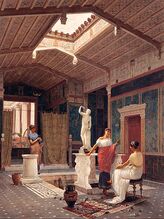
A family of residents in their house in the Eastern city.
Although Cin Amon is a large city, few people own citizenship rights. These rights are reserved for the members of the nobility, as well as the families who run the most important manufactures and trade houses in the outer burrows. The bulk of the population is made up of its vast workforce, which only holds a right of residency, and vary in skill from simple day laborers to talented artisans, engineers and architechts. Citizenship rights are used by the actual citizens as a means to ensure and reward loyalty among the residents. In fact, anyone can advance into the ranks of a noble house through adoption and thus gain citizenship rights, should a noble house regard this profitable.
Besides the citizens and the residents there is a third group of people living in the city, an oppressed group which are forcibly brought here as prisoners of war (or as a form of tribute from defeated rival towns) and who must live in the city as slave laborers. Their houses are located in a separated burrow (19) in the outer ring, which is guarded at all times. Slave laborers are subject only to the city authority. They are required to work for Cin Amon for ten years, after which they regain their freedom. Afterward, a citizen or resident will commonly offer residency to the family of a former slave in order to keep their experience available for the workforce.
Religion[]
The steppes, hills and oasis have been lands of migration for all of recorded history. As nomadic peoples came in from the far East, local peoples have merged with the newcomers. As a result, Cin Amon has always been a place where cultures, politics and faiths mix and mingle. Few teachings held sacred originated here, and the bulk of what people know and believe in the Circle City is shared with other places and peoples throughout this world.
Shrines and minor temples can be found throughout the Inner City, as well as the market and residential districts. However, there is a form of organized religion. The most important places of worship are the Great Pantheon (10) and the Minor Pantheon (16). The former houses prestigious altars to the major gods of the world, with special attention given to the most important trading partners of Cin Amon. Foreign priests of all faiths must tend to the many needs of the numerous visitors here. The minor pantheon however is mostly visited by residents of the city, among whom Khan Bhaalic is very popular. The rest of the smaller pantheon is bulked up with a myriad of obscure, sometimes forgotten shrines.
The wonderous temple to the Elven deity of inspiration (17) deserves special mention. The magnificent statue of the deity was a gift from Ebreosea, awarded for the help the Circle City lended the Elves during the Second Pirate War. However, the statue is made of a mysterious teal marble completely alien to these lands, and a unique kind of gemstone giving it a fiery gaze. Local scholars have claimed that it is a relic from the mystic Elven homeland of Kel'tarath, but the Elves have taken great care never to confirm this. In any case, the exemplary craftsmanship of the statue enrages the artists of the Circle City with burning jealousy, which is in turn the reason why Ebreoseans like to take credit for the high quality of the art created in Cin Amon.
Ethnicity[]
Historically, this land was first settled by gnomes living in the hills around what is today Cin Amon. These hill peoples most likely came from 53 - Nature. Some scholars believe they then moved to the oases in the vincinity, east and west of Cin Amon, and became culturally distinct from the gnomes of the hills. Others believe the oasis gnomes hail from the North-East, the lands around Thistlepot Junction.
In more recent history, nomadic peoples of humans and halflings, which had already formed diverse clans, moved in from the vast and rugged lands southeast of the fabled Prisma Heights. Some have argued that these clans share similiar folklore with the people of Caimaninae and 81 - City, far out East from Cin Amon. Quite possibly, their ancient migration was set in motion due to whatever cataclysm in the East led to the abandonment of the Citadel of Amin and the Lost capital of Mnar.
Elven influence in the lands around Cin Amon has likely always been present. There is evidence of very early Elven exploration in these lands, but those tales are hidden away in forgotten tomes deep in the librarries of Cin Amon and Ebreosea. Most, though not all, researchers have argued that Elves migrated here from the West, stemming from settlements around the seas of Ebreosea.
Today, the people of the Circle City, the population of the surrounding settlements, and the clanspeople of the nomadic tribes in the region look back on centuries of shared family history. A toursit walking the streets of Cin Amon can never be sure if they are looking at a tall halfling or a short human, or at an athletic dwarf or a fat gnome. Hairiness further complicates the matter. The majority of the inhabitants of the region is of mixed origins all throughout this world, and will not worry very much about their historic origins. Class membership is much more important here. Assuming every diplomat is automatically a half-elf will certainly brand you an outsider, but adressing someone who displays a Citizen Broach of Cin Amon proudly as anything else will likely get you flogged in public.
Law & Order[]
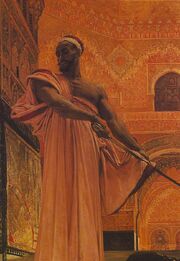
The Law in the Circle City
Crime and punishment[]
Cin Amon has no prisons and barely even a handful of jail cells. Begzadii judges alone hold court only over fellow citizens, and in trails the testimony of witnesses is most important of all. Unless a resident or slave enjoys the protection of a citizen, the suspicion of a crime is enough to justify punishment of the alleged offenders. Note that giving false witness is also a crime.
However, there is only one form of punishment: banishment. The dry wastes surrounding Cin Amon and its rival cities are harsh and unforgiving, and survival here is inextricably linked to life in a community. Those who are banished can only hope to be accepted in another settlement or nomadic clan, but these are wary of expelled criminals and may only allow them entry if they surrender themselves as slaves.
People who are found guilty of the worst offences, such as murder, will likely be marked with a visible tattoo, so they will be recognized as criminals wherever they go. For these lost souls, banishment almost immediately translates into death. As such, the prospect of being expelled to the unforgiving wastes is the nobilities' primary means of instilling respect for the law in the population, and few but the most desperate ever even consider the crime.
The matter is, of course, different for the Begzadii. Rare as it is, Begzadii sometimes are caught in criminal activity. In these cases, the offenders and their families are not banished, but ostracized for a number of years. They loose their status as a Begzadii, and may take all of their property with them and usually go live in a different place for the duration of their exile. Afterwards, they are permitted to return to Cin Amon as residents.
Military[]

The Circle city barely keeps people under weapons, yet it is near impenetrable. Besides is mighty double walls and imposing round towers, its might is due to a unique accomblisment in gnomish engineering: the miraculous fire throwing towers. The strongest towers guarding the city walls are topped with large parabolic mirrors which capture light from the sun by day (and from magical sources by night) and focus the rays into powerful beams of sheer heat. Attackers in considerable distance from the city will be blinded, then subjected to unbearable heat and, finally, burst into flames alive if under the influence of these mirrors long enough.
A standing military of any form is not supported by the city. Large groups of mercenaries are easily hired with the vast riches of the citizens, and talented fighters are native to the surrounding lands. Such mercenary armies will only be raised if waging war against a neighbour city or clan is desired.
The city guard is the only instutution charged with policing the population of Cin Amon. Its primary jobs are the guarding of the burrow of the slave laborers, handling customs with incoming and outgoing trade, as well as collecting taxes and tolls from outsiders. Furthermore, no disturbance of the peace will be tolerated. If the guard observes any sort of deviant behavior, they will react with harshness, then violence, and finally, if the offense persists, the suspect will be jailed to be subjected to banishment later.




